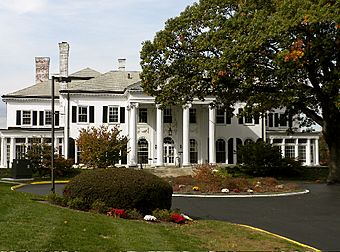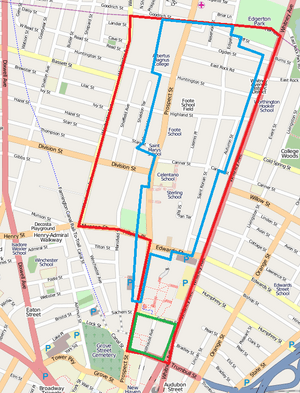Prospect Hill Historic District (New Haven, Connecticut) facts for kids
Quick facts for kids |
|
|
Prospect Hill Historic District
|
|

Palladian Louis Stoddard House (1905), 700 Prospect St., Peabody and Stearns, Boston, now on the campus of Albertus Magnus College.
|
|
| Location | Prospect Street and St. Ronan Street, New Haven, Connecticut |
|---|---|
| Area | 185 acres (75 ha) |
| Built | 1890 |
| Architect | Brown & Von Beren; Multiple |
| Architectural style | Colonial Revival, Tudor Revival, Queen Anne |
| NRHP reference No. | 79002670 |
| Added to NRHP | November 2, 1979 |
The Prospect Hill Historic District is a special area in New Haven, Connecticut. It covers about 185 acres and is filled with historic buildings. This district is important because it shows off many different styles of architecture from the past.
It includes most of the homes in the Prospect Hill neighborhood. In 1979, this district was added to the National Register of Historic Places. At that time, it had 238 buildings that were considered important to the area's history.
Contents
Discovering Prospect Hill's History
This historic district is famous mostly for its amazing buildings. You can see many different architectural styles here. Some of the main styles include Queen Anne, Shingle Style, Colonial Revival, and Tudor Revival. Many other styles are also present, making it a diverse collection of old homes.
Many famous architects and design companies helped create these buildings. Some came from Boston, like Peabody and Stearns. Others were from New York, such as Grosvenor Atterbury and James Gamble Rogers. Even local Connecticut architects like Henry Austin contributed to the district's unique look.
Important Buildings to See
Here are some of the special buildings in the Prospect Hill Historic District:
Historic Homes and Their Styles
- John M. Davies house: Located at 393 Prospect Street, this house was built in 1868. It's a great example of the Second French Empire Revival style. Henry Austin designed it, and it shows what the earliest homes in the district looked like. Today, it's known as Betts House.
- Othniel C. Marsh House: Found at 360 Prospect Street, this house was built in 1878. It mixes Richardsonian Romanesque and Queen Anne styles. The company J.C. Cady & Co. designed it.
- Connecticut Agricultural Experiment Station: This property includes six buildings built between 1875 and around 1950. It's so important that it's also a separate National Historic Landmark.
- Anna L. Graves House: This Queen Anne style house was built around 1890 at 35 Autumn Street.
- Homes on Canner Street: Six Colonial Revival houses built between 1900 and 1910 are located at 259-61, 262, 266, 269, 270-272, and 278 Canner Street.
- 237 East Rock Road: Built around 1910, this home is Colonial Revival with Federal details. It used to be the home of A. Whitney Griswold, a president of Yale University.
- Silk House: This Colonial Revival house was built around 1915 at 75 Autumn Street. Architects Brown & VanBeren designed it.
- Shingle Style Houses: You can find three Shingle Style houses at 152, 166, and 180 East Rock Road.
- Celentano Public School: At 370 Canner Street, this building has a Victorian style. It was originally built as Yale's first observatory.
- 80 Cliff Street: This is a Queen Anne house, built around 1890.
- Ellsworth Foote House: Located at 145 East Rock Road, this is one of four Shingle Style houses, along with 152, 166, and 180 East Rock Road.
- 149 and 156 East Rock Road: These are two more Queen Anne houses.
Buildings That Don't "Contribute"
Some buildings in the area are not considered "contributing" to the historic district. This means they don't fit the historic look or were built much later. For example, four dormitories at the Yale Divinity School (352 Canner Street) were built in 1957. Their modern design doesn't match the older neighborhood style.
In 2002, a building at 285 Prospect Street, designed by R. Clipston Sturgis, was moved to 380 Edwards Street. It kept its status as a contributing building even after being moved.

How the District Fits In
The Prospect Hill Historic District covers most of the residential part of New Haven's Prospect Hill neighborhood. The district's boundaries are drawn carefully to leave out newer buildings. It also excludes properties along Whitney Avenue, which are part of the Whitney Avenue Historic District.
The district does not include the Hillhouse Avenue Historic District. This area, once residential, is now mostly owned by Yale University. It also doesn't include the Edgerton historic district.
The district also leaves out some of Yale University's more modern buildings on Science Hill. It excludes several Yale graduate student housing buildings, like the Whitehall Apartment Complex. However, it does include four dormitory buildings of the Yale Divinity School at 352 Canner Street.
The district extends south to include historic houses on the west side of Prospect Street, south of Hillside Place. These houses are now used as Yale offices.
Gallery
-
George Berger House (1927), 810 Prospect St., Douglas Orr, now on the campus of Albertus Magnus College.










